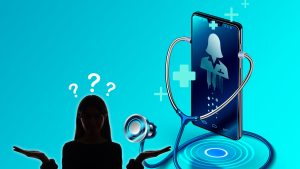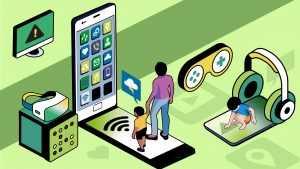
Youth are increasingly accessing and sharing health information online, independent of the traditional channels of doctor-patient and parent-child communication. While there is a wealth of useful information to be found, children and teens are also encountering misinformation, negative health messages, and peer-created content that may not be relaying credible information.
How can families, schools, and communities encourage digital health literacy and help children use a critical lens to find trusted sources for health advice? Children and Screens convened a panel of researchers, clinicians, and public health experts to discuss these issues and offer tips to youth to evaluate the health information they find online.
What Is Digital Health Literacy?
“Health literacy is the degree to which people can get, process, understand and communicate about health-related information to make informed health decisions. Given today’s connected world, health literacy is also heavily tied to the online environment and electronic information sources. Digital health literacy is applying that idea of health literacy to digital information sources.”
– Jennifer Manganello, PhD, MPH
Professor of Health Policy, Management and Behavior, University at Albany, SUNY
What Does Misinformation Look Like?
“It takes a lot of forms, but there’s a few simple rules:
- Using correlation versus causation – implying two events that co-occur are related or causal in nature: for example, by claiming the rise in vaccination rates is causing the rise in autism diagnoses
- Using emotional (especially fear) appeals with a very compelling picture that grabs our attention. “Destroying the lives of children one injection at a time.” It’s memorable. It breaks through the clutter. It can also be a form of implicit misinformation that is harder to identify or tag.
- “Just asking questions” is a common strategy – you’re not exactly saying something is inaccurate. You’re “just asking a question” that strongly undermines, or questions, best available evidence. This also goes along with impossible expectations – demanding a level of evidence that is not feasible to achieve.”
– Emily Vraga, PhD
Associate Professor, Hubbard School of Journalism and Mass Communication, Don & Carole Larson Professorship in Health Communication, University of Minnesota
5 Quick Signs of Misinformation (FLICC)
- Fake Experts
- Logical Fallacies
- Impossible Expectations
- Cherry Picking
- Conspiracy Theories
– Emily Vraga, PhD
Associate Professor, Hubbard School of Journalism and Mass Communication, Don & Carole Larson Professorship in Health Communication, University of Minnesota
(linked resource: https://skepticalscience.com/history-FLICC-5-techniques-science-denial.html)
Beware Of Algorithms And Echo Chambers
– Emily Vraga, PhD
Associate Professor, Hubbard School of Journalism and Mass Communication, Don & Carole Larson Professorship in Health Communication, University of Minnesota
“Algorithms behind TikTok will reshow you everything that you already liked. So if you find a teen who is hooked into content creators that may not be providing accurate information or pushing lifestyles that are not healthy, they’re going to see that content more than a teen who has never really engaged with that.”
– Robin Stevens
Associate Professor of Communication
USC Annenberg
“What [teens] are often doing is following influencers, peers who look like them or who can speak their language, who might not be beholding to the same accuracy standards, who might be presenting information in order to gain attention, to gain notoriety, to gain money, rather than presenting the best available information. This can also lead people to fall into echo chambers and filter bubbles, places where they’re seeing a lot of misinformation being repeated from a lot of different sources.”
Hubbard School of Journalism and Mass Communication, Don & Carole Larson Professorship in Health Communication, University of Minnesota
Tips For Family Dialogue And Action
Stress accuracy and verify sources
“When we’re on social media, we’re there for social reasons, and accuracy might not be our top goal. [Remind children] that accuracy is important. Ask them to reiterate to you that, ‘Yeah, I think information should be accurate.’ Give them news literacy tips or invoke social norms – ‘In this house, we really want to only share accurate information. We really only want to see accurate information.’ All of those things can make people less likely to share misinformation and to respond to it. […]
Teach young people to be looking outside of where they are for verification, but not necessarily just clicking the top source that they see, but looking at lots of different information, checking their bearings. If no prominent expert or news organization is reporting on it, it might not be true.”
– Emily Vraga, PhD
Associate Professor
Hubbard School of Journalism and Mass Communication, Don & Carole Larson Professorship in Health Communication, University of Minnesota
Lean on dialogue, not controls
– Paul Weigle, MD
Child and Adolescent Psychiatrist, Associate Medical Director of Ambulatory Services
Natchaug Hospital
Chair of the Media Committee
American Academy of Child and Adolescent Psychiatry
– Jessica Willoughby, PhD
Washington State University
Hubbard School of Journalism and Mass Communication, Don & Carole Larson Professorship in Health Communication, University of Minnesota
Help children establish appropriate boundaries with peers
Natchaug Hospital
Chair of the Media Committee
American Academy of Child and Adolescent Psychiatry
– Robin Stevens, PhD, MPH
USC Annenberg
Identify resources before they need them
“If we’re at a moment where we’re really having a lot of affective feelings, where we’re worried about something, we’re concerned, and then we’re going on and seeking information, it might make it so that we have more trouble deciphering the good sources from the bad or really understanding that content in the context of the things that we need to be thinking through.”
– Jessica Willoughby, PhD
Associate Professor of Strategic Communication
Washington State University
“A great place for parents and caregivers and providers to start to look on their own is Tik-tok and on Instagram, to see what content creators resonate. Realistically, young people aren’t likely going to websites as much as we do. It’s a great way to teach, to find people and say, “Hey, have you seen this?” Just start to introduce different credible sources that are “hip” and “cool.”
– Robin Stevens, PhD, MPH
Associate Professor of Communication
USC Annenberg
– Jessica Willoughby, PhD
Associate Professor of Strategic Communication
Washington State University
What to do when your child self-diagnoses using online information
– Paul Weigle, MD
Child and Adolescent Psychiatrist, Associate Medical Director of Ambulatory Services
Natchaug Hospital
Chair of the Media Committee
American Academy of Child and Adolescent Psychiatry










